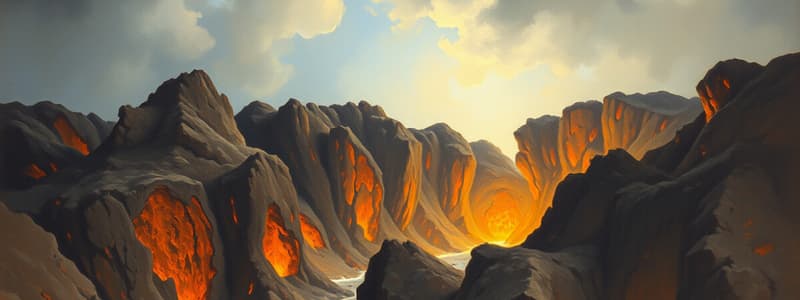Podcast
Questions and Answers
What is an igneous intrusion?
What is an igneous intrusion?
Hot molten material that has forced its way into the crust through lines of weaknesses and has solidified before reaching the surface.
Name the 3 types of igneous intrusions.
Name the 3 types of igneous intrusions.
Sill, dyke, batholith/pluton.
State whether each of the following is concordant or discordant: sill, batholith and dyke.
State whether each of the following is concordant or discordant: sill, batholith and dyke.
Sill = Concordant Batholith = Discordant Dyke = Discordant
How are baked margins formed?
How are baked margins formed?
How many baked margins does a sill, dyke, and lava flow have?
How many baked margins does a sill, dyke, and lava flow have?
What is a batholith?
What is a batholith?
What is the composition of a batholith and what rock do they cool to form (usually)?
What is the composition of a batholith and what rock do they cool to form (usually)?
What is the name for the baked margin region for a batholith and how is this represented on a map?
What is the name for the baked margin region for a batholith and how is this represented on a map?
How may intrusive igneous rocks be brought to the surface?
How may intrusive igneous rocks be brought to the surface?
Rocks that solidify within the crust cool over long periods of time, what size crystals do they form?
Rocks that solidify within the crust cool over long periods of time, what size crystals do they form?
Intrusions cause baked AND chilled margins, explain how? Also how may this impact crystal size?
Intrusions cause baked AND chilled margins, explain how? Also how may this impact crystal size?
Sills and dykes form closer to the Earth's surface than batholiths meaning they cool faster - how will this affect the crystal size of dykes and sills and based on this what type of rock are these features formed from?
Sills and dykes form closer to the Earth's surface than batholiths meaning they cool faster - how will this affect the crystal size of dykes and sills and based on this what type of rock are these features formed from?
Flashcards are hidden until you start studying
Study Notes
Igneous Intrusions Overview
- Igneous intrusions consist of hot molten material that penetrates the Earth’s crust through weaknesses and solidifies below the surface.
Types of Igneous Intrusions
- The three types include sills, dykes, and batholiths/plutons.
Concordant vs. Discordant
- Sills are classified as concordant intrusions, fitting between existing layers of rock.
- Batholiths and dykes are discordant, cutting across other rock layers.
Formation of Baked Margins
- Baked margins result from the heat of intrusions that metamorphose surrounding country rock, a process known as contact metamorphism.
Baked Margins Count
- Sills and dykes each have two baked margins, while lava flows possess only one.
Batholith Description
- A batholith is a massive magma chamber that solidifies deep within the Earth, exposed only after extended geological periods.
Composition of Batholiths
- Batholiths are typically silicic and cool to form coarse-grained plutonic rocks, including granite, granodiorite, and diorite.
Metamorphic Aureole
- The baked margin region surrounding a batholith is termed a metamorphic aureole, illustrated on maps as a curved line following the intrusion.
Exposure of Intrusive Igneous Rocks
- Intrusive igneous rocks may reach the surface through processes such as erosion or uplift.
Crystal Size in Intrusive Rocks
- Rocks that cool within the crust develop larger crystals, typically over 2 mm in diameter.
Baked and Chilled Margins
- Baked margins are created by contact metamorphism from the intrusion's heat, while chilled margins result from the surrounding rock cooling the intrusion.
- This temperature variation leads to finer crystals on the outer edges and larger crystals toward the center.
Crystal Size and Rock Types
- Sills and dykes, cooling closer to the surface, form medium-grained rocks with crystal sizes reflecting a slower cooling process.
- These intrusions typically result in dark-colored medium-grained rock, commonly dolerite.
Studying That Suits You
Use AI to generate personalized quizzes and flashcards to suit your learning preferences.




